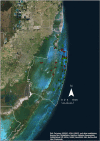Evaluating the effects of large marine predators on mobile prey behavior across subtropical reef ecosystems
- PMID: 31938478
- PMCID: PMC6953565
- DOI: 10.1002/ece3.5784
Evaluating the effects of large marine predators on mobile prey behavior across subtropical reef ecosystems
Abstract
The indirect effect of predators on prey behavior, recruitment, and spatial relationships continues to attract considerable attention. However, top predators like sharks or large, mobile teleosts, which can have substantial top-down effects in ecosystems, are often difficult to study due to their large size and mobility. This has created a knowledge gap in understanding how they affect their prey through nonconsumptive effects. Here, we investigated how different functional groups of predators affected potential prey fish populations across various habitats within Biscayne Bay, FL. Using baited remote underwater videos (BRUVs), we quantified predator abundance and activity as a rough proxy for predation risk and analyzed key prey behaviors across coral reef, sea fan, seagrass, and sandy habitats. Both predator abundance and prey arrival times to the bait were strongly influenced by habitat type, with open homogenous habitats receiving faster arrival times by prey. Other prey behaviors, such as residency and risk-associated behaviors, were potentially driven by predator interaction. Our data suggest that small predators across functional groups do not have large controlling effects on prey behavior or stress responses over short temporal scales; however, habitats where predators are more unpredictable in their occurrence (i.e., open areas) may trigger risk-associated behaviors such as avoidance and vigilance. Our data shed new light on the importance of habitat and context for understanding how marine predators may influence prey behaviors in marine ecosystems.
Keywords: baited remote underwater video stations; predation risk; predator; risk effects; sharks.
© 2019 The Authors. Ecology and Evolution published by John Wiley & Sons Ltd.
Conflict of interest statement
The authors declare no competing interests.
Figures






Similar articles
-
Effects of exposure to large sharks on the abundance and behavior of mobile prey fishes along a temperate coastal gradient.PLoS One. 2020 Mar 16;15(3):e0230308. doi: 10.1371/journal.pone.0230308. eCollection 2020. PLoS One. 2020. PMID: 32176723 Free PMC article.
-
Top predators induce habitat shifts in prey within marine protected areas.Oecologia. 2019 Jun;190(2):375-385. doi: 10.1007/s00442-019-04421-0. Epub 2019 Jun 3. Oecologia. 2019. PMID: 31155681
-
Central-place foraging and ecological effects of an invasive predator across multiple habitats.Ecology. 2016 Oct;97(10):2729-2739. doi: 10.1002/ecy.1477. Epub 2016 Sep 1. Ecology. 2016. PMID: 27859117
-
Fire as a driver and mediator of predator-prey interactions.Biol Rev Camb Philos Soc. 2022 Aug;97(4):1539-1558. doi: 10.1111/brv.12853. Epub 2022 Mar 23. Biol Rev Camb Philos Soc. 2022. PMID: 35320881 Free PMC article. Review.
-
Cascading top-down effects of changing oceanic predator abundances.J Anim Ecol. 2009 Jul;78(4):699-714. doi: 10.1111/j.1365-2656.2009.01531.x. Epub 2009 Mar 9. J Anim Ecol. 2009. PMID: 19298616 Review.
Cited by
-
Effects of exposure to large sharks on the abundance and behavior of mobile prey fishes along a temperate coastal gradient.PLoS One. 2020 Mar 16;15(3):e0230308. doi: 10.1371/journal.pone.0230308. eCollection 2020. PLoS One. 2020. PMID: 32176723 Free PMC article.
-
Sharks are the preferred scraping surface for large pelagic fishes: Possible implications for parasite removal and fitness in a changing ocean.PLoS One. 2022 Oct 19;17(10):e0275458. doi: 10.1371/journal.pone.0275458. eCollection 2022. PLoS One. 2022. PMID: 36260545 Free PMC article.
-
Drivers of variation in occurrence, abundance, and behaviour of sharks on coral reefs.Sci Rep. 2022 Jan 14;12(1):728. doi: 10.1038/s41598-021-04024-x. Sci Rep. 2022. PMID: 35031666 Free PMC article.
-
Behaviour of mesopredatory coral reef fishes in response to threats from sharks and humans.Sci Rep. 2023 Apr 25;13(1):6714. doi: 10.1038/s41598-023-33415-5. Sci Rep. 2023. PMID: 37185796 Free PMC article.
References
-
- Armstrong, J. D. , Bagley, P. M. , & Priede, I. G. (1992). Photographic and acoustic tracking observations of the behaviour of the grenadier Coryphaenoides (Nematonurus) armatus the eel Synaphobranchus bathybius, and other abyssal demersal fish in the North Atlantic Ocean. Marine Biology, 112(4), 535–544. 10.1007/BF00346170 - DOI
-
- Beauchamp, D. A. , Wahl, D. , & Johnson, B. M. (2007). Predator‐prey interactions In Guy C. S., & Brown M. J. (Eds.), Analysis and interpretation of freshwater fisheries data (pp. 765–842). Bethesda, MD: American Fisheries Society.
-
- Bethea, D. M. , Hale, L. , Carlson, J. K. , Cortés, E. , Manire, C. A. , & Gelsleichter, J. (2007). Geographic and ontogenetic variation in the diet and daily ration of the bonnethead shark, Sphyrna tiburo, from the eastern Gulf of Mexico. Marine Biology, 152(5), 1009–1020. 10.1007/s00227-007-0728-7 - DOI
-
- Beukers‐Stewart, B. D. , Beukers-Stewart, J. S. , & Jones, G. P. (2011). Behavioural and developmental responses of predatory coral reef fish to variation in the abundance of prey. Coral Reefs, 30(3), 855–864.
Associated data
LinkOut - more resources
Full Text Sources
Miscellaneous

